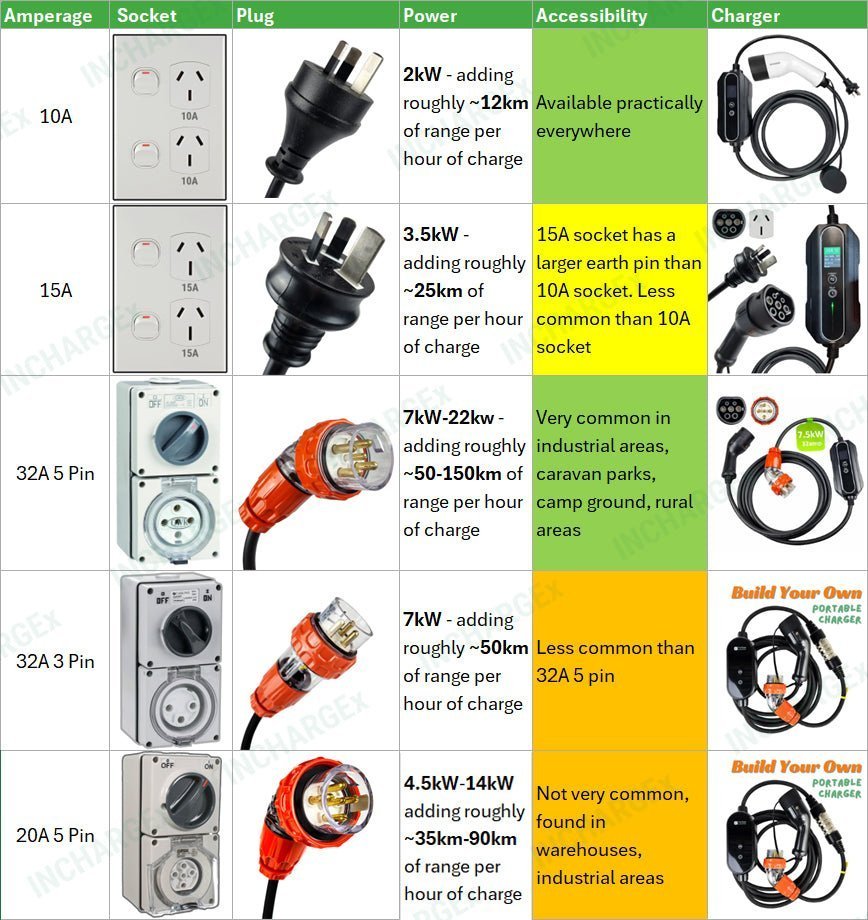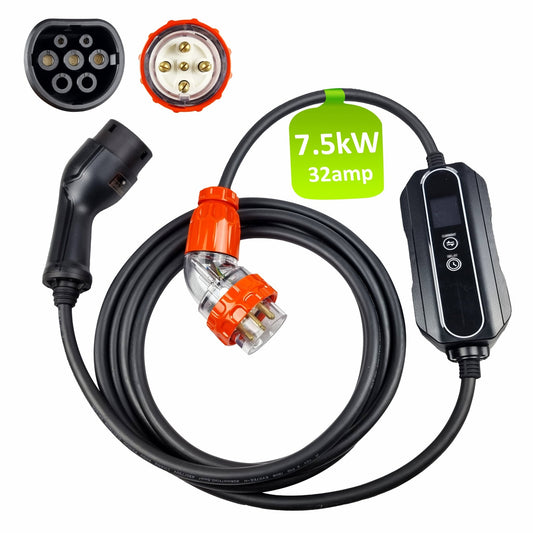Your Quick Guide to EV Charging Plugs and Sockets in Australia
When it comes to charging your EV in Australia, understanding the different plugs and sockets is key. We've got you covered with a rundown of the most common types you’ll encounter.
Available Plugs and Sockets
This table shows the most common socket, the power rating that they can supply and a rough estimate of added range per hour of charge.

Selecting The Right Portable EV Charger
For those looking to choose the perfect portable EV charger, we've created a detailed guide to help our customers make the best decision. Check it out here.
Using Adapters for Different Sockets:
Generally, avoid using extension cords for EV charging, as standard household cords aren't designed to handle the high loads that occur during charging.
When using adapters, ensure you’re matching the same amperage from one plug to another. For instance, using a 10A charger in a 15A socket is fine since the charger only draws 10A. However, if you need to use a higher-power charger in a lower-rated socket, the adapter must have a built-in breaker or current limiter to prevent overloading.
Adapters that simply wire a 15A plug to a 10A socket without protection can cause damage, overheating, or even fire hazards. We strongly advise our customers against using such adapters for safety reasons.


Proper Use of Industrial Plugs
When using a 32A 5-pin or 32A 3-pin industrial plug, it's crucial to insert the plug fully into the socket, ensuring there's no gap between the black rubber ring on the plug and the white plastic ring in the socket. Tighten the orange ring securely for a proper connection. New sockets can be tight, and customers may not realize the plug isn’t fully inserted, which can create gaps leading to sparking and overheating of both the socket and plug.

Even though plugs and sockets on the market are built tough for Australian conditions, they can still wear out over time. The following are the most common reasons plugs and sockets wear out.
- Mechanical wear and tear: Frequent plugging and unplugging can cause physical wear on the pins and socket contacts. This may lead to loosening of connections over time.
- Vibration and Movement: In environments where the plug and socket are subject to vibration or movement, screws can gradually loosen, compromising the electrical connection.
- Electrical Load: If the plug and socket are consistently operated near their maximum rated load (32A in this case), they are more likely to experience thermal stress, accelerating degradation.
- Thermal cycling: The heating and cooling cycles that occur during normal use can cause expansion and contraction of metal components, potentially loosening screws and connections.
- Corrosion: Environmental factors like humidity or exposure to certain chemicals can cause corrosion of metal parts, affecting the quality of electrical connections.
- Poor initial installation: If the plug or socket was not properly installed initially, with screws not tightened sufficiently, it can lead to problems developing more quickly.
- Water Ingress: Moisture inside plugs, sockets, or adapters can cause short circuits, corrosion, or increased contact resistance, leading to overheating, melting, or even electrical failure. Always ensure connections are dry and protected from rain or splashes, especially in outdoor or damp environments
Effects of degradation
As these components degrade, several issues can arise:
- Loose connections: Screws holding wires in place can become loose, leading to poor contact and increased resistance.
- Arcing: Poor connections can cause arcing, where electricity jumps across a gap, generating heat and potentially damaging the plug and socket.
- Overheating and melting: The increased resistance from loose connections can generate excessive heat, potentially leading to melting of plastic components like shown here.

To prevent these issues, regular inspection and maintenance of high-current plugs and sockets is crucial. If any signs of wear, looseness, or overheating are observed, the components should be replaced immediately to ensure safety and proper functionality.
Recommended Maintenance Tips
To keep your EV charging equipment safe and reliable for years, we recommend the following simple steps:
- Inspect regularly – Check plugs, sockets, and cables for signs of wear, looseness, or overheating before use.
- Keep connections dry – Always ensure plugs and sockets are free from water or moisture before charging, especially outdoors.
- Tighten connections – If you notice loose screws or fittings on industrial sockets, have a licensed electrician re-secure them.
- Avoid overloading – Only use chargers with sockets rated for the same or higher current; never force mismatched connections.
- Plug in fully – Make sure industrial plugs are fully seated and locking rings are tightened to prevent gaps that cause arcing.
- Clean gently – Wipe dust and debris from plugs and sockets with a dry cloth; never use harsh cleaners or water.
- Replace when worn – If you notice burnt marks, melted plastic, or persistent looseness, stop using the equipment and replace it promptly.
These simple habits help reduce wear, improve safety, and extend the lifespan of your EV charging equipment—regardless of the brand.









